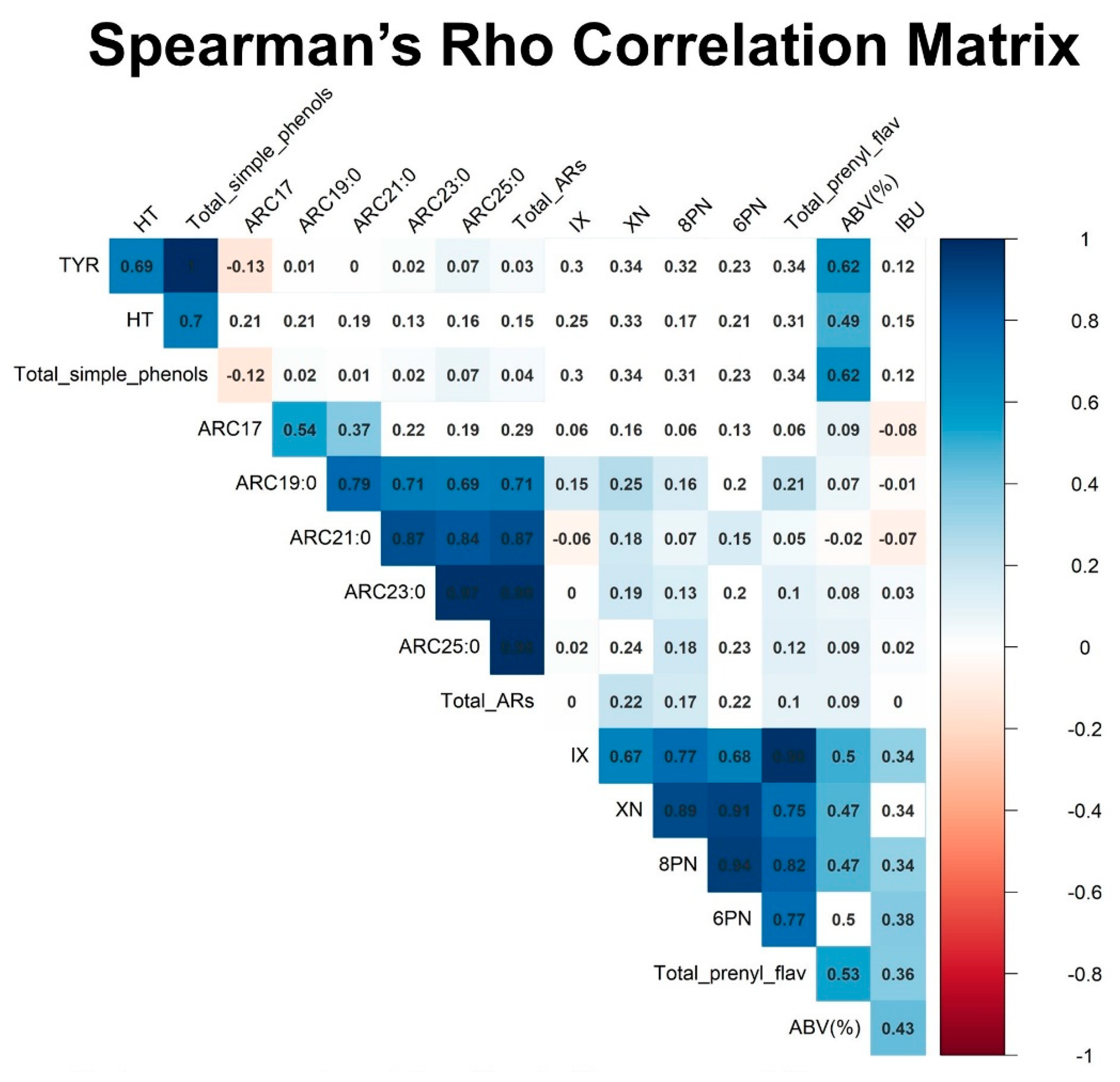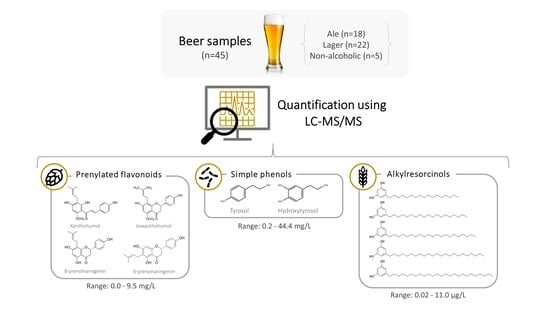Beer Phenolic Composition of Simple Phenols, Prenylated Flavonoids and Alkylresorcinols
Abstract
1. Introduction
2. Results
2.1. Beers Characterization
2.2. Prenylated Flavonoids
2.3. Simple Phenols
2.4. Alkylresorcinols
2.5. Correlation Study
2.6. Beer Styles
3. Discussion
4. Materials and Methods
4.1. Chemicals and Reagents
4.2. Samples and Sample Preparation
4.3. Extraction and Analysis of Prenylated Flavonoids: IX, XN, 8PN and 6PN
4.4. Extraction and Analysis of Simple Phenols TYR and HT in Beer
4.5. Extraction and Analysis of ARs in Beer
4.6. Statistical Analysis
Supplementary Materials
Author Contributions
Funding
Conflicts of Interest
References
- World Health Organization. Global Status Report on Alcohol and Health 2018; World Health Organization: Geneva, Switzerland, 2018. [Google Scholar]
- Poli, A.; Marangoni, F.; Avogaro, A.; Barba, G.; Bellentani, S.; Bucci, M.; Cambieri, R.; Catapano, A.L.; Costanzo, S.; Cricelli, C.; et al. Moderate alcohol use and health: A consensus document. Nutr. Metab. Cardiovasc. Dis. 2013, 23, 487–504. [Google Scholar] [CrossRef] [PubMed]
- Costanzo, S.; Di Castelnuovo, A.; Donati, M.B.; Iacoviello, L.; de Gaetano, G. Wine, beer or spirit drinking in relation to fatal and non-fatal cardiovascular events: A meta-analysis. Eur. J. Epidemiol 2011, 26, 833–850. [Google Scholar] [CrossRef] [PubMed]
- de Gaetano, G.; Costanzo, S.; Di Castelnuovo, A.; Badimon, L.; Bejko, D.; Alkerwi, A. Effects of moderate beer consumption on health and disease: A consensus document. Nutr. Metab Cardiovasc Dis 2016, 26, 443–467. [Google Scholar] [CrossRef] [PubMed]
- Chiva-Blanch, G.; Arranz, S.; Lamuela-Raventos, R.M.; Estruch, R. Effects of wine, alcohol and polyphenols on cardiovascular disease risk factors: Evidences from human studies. Alcohol Alcoholism 2013, 48, 270–277. [Google Scholar] [CrossRef] [PubMed]
- Jerkovic, V.; Callemien, D.; Collin, S. Determination of stilbenes in hop pellets from different cultivars. J. Agric Food Chem 2005, 53, 4202–4206. [Google Scholar] [CrossRef]
- Wannenmacher, J.; Gastl, M.; Becker, T. Phenolic Substances in Beer: Structural Diversity, Reactive Potential and Relevance for Brewing Process and Beer Quality. Compr. Rev. Food Sci. Food Saf. 2018, 17, 953–988. [Google Scholar] [CrossRef]
- Neveu, V.; Perez-Jiménez, J.; Vos, F.; Crespy, V.; du Chaffaut, L.; Mennen, L. Phenol-Explorer: An online comprehensive database on polyphenol contents in foods. Database (Oxford) 2010, 2010, bap024. [Google Scholar] [CrossRef]
- Gerhäuser, C. Beer constituents as potential cancer chemopreventive agents. Eur. J. Cancer 2005, 41, 1941–1954. [Google Scholar] [CrossRef]
- Nardini, M.; Natella, F.; Scaccini, C.; Ghiselli, A. Phenolic acids from beer are absorbed and extensively metabolized in humans. J. Nutr. Biochem. 2006, 17, 14–22. [Google Scholar] [CrossRef]
- Piazzon, A.; Forte, M.; Nardini, M. Characterization of phenolics content and antioxidant activity of different beer types. J. Agric. Food Chem. 2010, 58, 10677–10683. [Google Scholar] [CrossRef]
- Floridi, S.; Montanari, L.; Marconi, O.; Fantozzi, P. Determination of free phenolic acids in wort and beer by coulometric array detection. J. Agric. Food Chem. 2003, 51, 1548–1554. [Google Scholar] [CrossRef] [PubMed]
- Řehová, L.; Škeříkova, V.; Jandera, P. Optimisation of gradient HPLC analysis of phenolic compounds and flavonoids in beer using a CoulArray detector. J. Sep. Sci. 2004, 27, 1345–1359. [Google Scholar] [CrossRef] [PubMed]
- Jandera, P.; Škeříková, V.; Řehová, L.; Hájek, T.; Baldriánová, L.; Škopová, G. RP-HPLC analysis of phenolic compounds and flavonoids in beverages and plant extracts using a CoulArray detector. J. Sep. Sci. 2005, 28, 1005–1022. [Google Scholar] [CrossRef] [PubMed]
- Nardini, M.; Garaguso, I. Characterization of bioactive compounds and antioxidant activity of fruit beers. Food Chem. 2020, 305, 125437. [Google Scholar] [CrossRef]
- Quifer-Rada, P.; Vallverdú-Queralt, A.; Martínez-Huélamo, M.; Chiva-Blanch, G.; Jáuregui, O.; Estruch, R. A comprehensive characterisation of beer polyphenols by high resolution mass spectrometry (LC-ESI-LTQ-Orbitrap-MS). Food Chem. 2015, 169, 336–343. [Google Scholar] [CrossRef]
- Osorio-Paz, I.; Brunauer, R.; Alavez, S. Beer and its non-alcoholic compounds in health and disease. Crit. Rev. Food Sci. Nutr. 2019, 2019, 1–14. [Google Scholar] [CrossRef]
- Hernandes, K.C.; Souza-Silva, É.A.; Assumpção, C.F.; Zini, C.A.; Welke, J.E. Validation of an analytical method using HS-SPME-GC/MS-SIM to assess the exposure risk to carbonyl compounds and furan derivatives through beer consumption. Food Addit. Contam. Part. A 2019, 36, 1808–1821. [Google Scholar] [CrossRef]
- Quifer-Rada, P.; Martínez-Huélamo, M.; Chiva-Blanch, G.; Jáuregui, O.; Estruch, R.; Lamuela-Raventós, R.M. Urinary Isoxanthohumol Is a Specific and Accurate Biomarker of Beer Consumption. J. Nutr. 2014, 144, 484–488. [Google Scholar] [CrossRef][Green Version]
- Chen, X.; Mukwaya, E.; Wong, M.-S.; Zhang, Y. A systematic review on biological activities of prenylated flavonoids. Pharm Biol 2014, 52, 655–660. [Google Scholar] [CrossRef]
- Stevens, J.F.; Page, J.E. Xanthohumol and related prenylflavonoids from hops and beer: To your good health! Phytochemistry 2004, 65, 1317–1330. [Google Scholar] [CrossRef]
- Štulíková, K.; Karabín, M.; Nešpor, J.; Dostálek, P. Therapeutic perspectives of 8-prenylnaringenin, a potent phytoestrogen from hops. Molecules 2018, 23, 660. [Google Scholar] [CrossRef]
- Arranz, S.; Chiva-Blanch, G.; Valderas-Martínez, P.; Medina-Remón, A.; Lamuela-Raventós, R.M.; Estruch, R. Wine, beer, alcohol and polyphenols on cardiovascular disease and cancer. Nutrients 2012, 4, 759–781. [Google Scholar] [CrossRef] [PubMed]
- Quesada-Molina, M.; Muñoz-Garach, A.; Tinahones, F.J.; Moreno-Indias, I. A New Perspective on the Health Benefits of Moderate Beer Consumption: Involvement of the Gut Microbiota. Metabolites 2019, 9, 272. [Google Scholar] [CrossRef] [PubMed]
- Li, M.; Yang, Z.; Hao, J.; Shan, L.; Dong, J. Determination of Tyrosol, 2-Phenethyl Alcohol, and Tryptophol in Beer by High-Performance Liquid Chromatography. J. Am. Soc. Brew. Chem. 2008, 66, 245–249. [Google Scholar] [CrossRef]
- Cerrato-Alvarez, M.; Bernalte, E.; Bernalte-García, M.J.; Pinilla-Gil, E. Fast and direct amperometric analysis of polyphenols in beers using tyrosinase-modified screen-printed gold nanoparticles biosensors. Talanta 2019, 193, 93–99. [Google Scholar] [CrossRef] [PubMed]
- Bartolomé, B.; Peña-Neira, A.; Gómez-Cordovés, C. Phenolics and related substances in alcohol-free beers. Eur. Food Res. Technol. 2000, 210, 419–423. [Google Scholar] [CrossRef]
- Hazelwood, L.A.; Daran, J.M.; Van Maris, A.J.A.; Pronk, J.T.; Dickinson, J.R. The Ehrlich pathway for fusel alcohol production: A century of research on Saccharomyces cerevisiae metabolism. Appl. Environ. Microbiol. 2008, 74, 2259–2266. [Google Scholar] [CrossRef]
- Piñeiro, Z.; Cantos-Villar, E.; Palma, M.; Puertas, B. Direct liquid chromatography method for the simultaneous quantification of hydroxytyrosol and tyrosol in red wines. J. Agric. Food Chem. 2011, 59, 11683–11689. [Google Scholar] [CrossRef]
- Boronat, A.; Mateus, J.; Soldevila-Domenech, N.; Guerra, M.; Rodríguez-Morató, J.; Varon, C. Cardiovascular benefits of tyrosol and its endogenous conversion into hydroxytyrosol in humans. A randomized, controlled trial. Free Radic. Biol. Med. 2019. [Google Scholar] [CrossRef]
- Soldevila-Domenech, N.; Boronat, A.; Mateus, J.; Diaz-Pellicer, P.; Matilla, I.; Pérez-Otero, M. Generation of the Antioxidant Hydroxytyrosol from Tyrosol Present in Beer and Red Wine in a Randomized Clinical Trial. Nutrients 2019, 11, 2241. [Google Scholar] [CrossRef]
- Robles-Almazan, M.; Pulido-Moran, M.; Moreno-Fernandez, J.; Ramirez-Tortosa, C.; Rodriguez-Garcia, C.; Quiles, J.L. Hydroxytyrosol: Bioavailability, toxicity, and clinical applications. Food Res. Int. 2018, 105, 654–667. [Google Scholar] [CrossRef] [PubMed]
- Landberg, R.; Marklund, M.; Kamal-Eldin, A.; Åman, P. An update on alkylresorcinols–Occurrence, bioavailability, bioactivity and utility as biomarkers. J. Funct. Foods 2014, 7, 77–89. [Google Scholar] [CrossRef]
- Rodríguez-Morató, J.; Jayawardene, S.; Huang, N.K.; Dolnikowski, G.G.; Galluccio, J.; Lichtenstein, A.H. Simplified method for the measurement of plasma alkylresorcinols: Biomarkers of whole-grain intake. Rapid Commun. Mass Spectrom. 2020, 34, e8805. [Google Scholar] [CrossRef] [PubMed]
- Chen, Y.; Ross, A.B.; Åman, P.; Kamal-Eldin, A. Alkylresorcinols as Markers of Whole Grain Wheat and Rye in Cereal Products. J. Agric. Food Chem. 2004, 52, 8242–8246. [Google Scholar] [CrossRef] [PubMed]
- Wang, Z.; Hao, Y.; Wang, Y.; Liu, J.; Yuan, X.; Sun, B. Wheat alkylresorcinols protect human retinal pigment epithelial cells against H2O2-induced oxidative damage through Akt-dependent Nrf2/HO-1 signaling. Food Funct. 2019, 10, 2797–2804. [Google Scholar] [CrossRef] [PubMed]
- Parikka, K.; Rowland, I.R.; Welch, R.; Wähälä, K. In vitro antioxidant activity and antigenotoxicity of 5-n-alkylresorcinols. J. Agric. Food Chem. 2006, 54, 1646–1650. [Google Scholar] [CrossRef]
- Oishi, K.; Yamamoto, S.; Itoh, N.; Nakao, R.; Yasumoto, Y.; Tanaka, K. Wheat alkylresorcinols suppress high-fat, high-sucrose diet-induced obesity and glucose intolerance by increasing insulin sensitivity and cholesterol excretion in male mice. J. Nutr. 2015, 145, 199–206. [Google Scholar] [CrossRef]
- Gharwalova, L.; Sigler, K.; Dolezalova, J.; Masak, J.; Rezanka, T.; Kolouchova, I. Resveratrol suppresses ethanol stress in winery and bottom brewery yeast by affecting superoxide dismutase, lipid peroxidation and fatty acid profile. World J. Microbiol. Biotechnol. 2017, 33, 205. [Google Scholar] [CrossRef]
- Capece, A.; Romaniello, R.; Pietrafesa, A.; Siesto, G.; Pietrafesa, R.; Zambuto, M. Use of Saccharomyces cerevisiae var. boulardii in co-fermentations with S. cerevisiae for the production of craft beers with potential healthy value-added. Int. J. Food Microbiol. 2018, 284, 22–30. [Google Scholar] [CrossRef]
- Basso, R.F.; Alcarde, A.R.; Portugal, C.B. Could non-Saccharomyces yeasts contribute on innovative brewing fermentations? Food Res. Int. 2016, 86, 112–120. [Google Scholar] [CrossRef]
- Ross, A.B. Analysis of Alkylresorcinols in Cereal Grains and Products Using Ultrahigh-Pressure Liquid Chromatography with Fluorescence, Ultraviolet, and CoulArray Electrochemical Detection. J. Agric. Food Chem. 2012, 60, 8954–8962. [Google Scholar] [CrossRef] [PubMed]
- Strong, G.; England, K. Guide of Styles 2015 Beer Judge Certification Program. 2015. Available online: https://www.bjcp.org/stylecenter.php (accessed on 25 May 2020).
Sample Availability: Samples of the compounds are not available from the authors. |


| Compound | All Beers | Type | pa | pb | pc | ||
|---|---|---|---|---|---|---|---|
| Ale | Lager | Non-Alcoholic | |||||
| IX (mg/L) | 0.34 (0.41) | 0.42 (0.54) | 0.33 (0.31) | 0.08 (0.08) | 0.76 | 0.06 | 0.06 |
| XN (mg/L) | 0.17 (0.87) | 0.39 (1.38) | 0.03 (0.04) | 0.01 (0.02) | 0.98 | 0.55 | 0.55 |
| 8PN (mg/L) | 0.03 (0.10) | 0.06 (0.15) | 0.02 (0.03) | 0.00 (0.00) | 0.78 | 0.55 | 0.49 |
| 6PN (mg/L) | 0.08 (0.34) | 0.17 (0.53) | 0.02 (0.03) | 0.01 (0.01) | 0.84 | 0.50 | 0.57 |
| Total PN (mg/L) | 0.62 (1.51) | 1.04 (2.33) | 0.40 (0.37) | 0.11 (0.98) | 0.80 | 0.17 | 0.17 |
| TYR (mg/L) | 11.45 (10.55) | 13.53 (12.94) | 11.58 (8.75) | 3.38 (2.60) | 0.87 | 0.01 | <0.01 |
| HT (mg/L) | 0.03 (0.03) | 0.04 (0.03) | 0.02 (0.02) | 0.01 (0.01) | 0.02 | 0.01 | 0.05 |
| Total simple phenols (mg/L) | 11.5 (10.5) | 13.6 (12.9) | 11.6 (8.8) | 3.4 (2.6) | 0.90 | 0.01 | 0.01 |
| AR-C17:0 (µg/L) | 0.00 (0.01) | 0.01 (0.02) | 0.00 (0.00) | 0.00 (0.00) | 0.08 | 0.32 | 0.70 |
| AR-C19:0 (µg/L) | 0.07 (0.15) | 0.13 (0.20) | 0.03 (0.07) | 0.00 (0.00) | 0.44 | 0.44 | 0.44 |
| AR-C21:0 (µg/L) | 0.19 (0.40) | 0.39 (0.55) | 0.07 (0.18) | 0.02 (0.03) | 0.23 | 0.50 | 0.91 |
| AR-C23:0 (µg/L) | 0.17 (0.36) | 0.30 (0.49) | 0.09 (0.21) | 0.03 (0.02) | 0.27 | 0.45 | 0.68 |
| AR-C25:0 (µg/L) | 0.58 (1.19) | 1.04 (1.69) | 0.31 (0.59) | 0.15 (0.11) | 0.34 | 0.58 | 0.83 |
| Total ARs (µg/L) | 1.01 (2.03) | 1.87 (2.84) | 0.50 (1.04) | 0.2 (0.15) | 0.25 | 0.58 | 0.93 |
© 2020 by the authors. Licensee MDPI, Basel, Switzerland. This article is an open access article distributed under the terms and conditions of the Creative Commons Attribution (CC BY) license (http://creativecommons.org/licenses/by/4.0/).
Share and Cite
Boronat, A.; Soldevila-Domenech, N.; Rodríguez-Morató, J.; Martínez-Huélamo, M.; Lamuela-Raventós, R.M.; de la Torre, R. Beer Phenolic Composition of Simple Phenols, Prenylated Flavonoids and Alkylresorcinols. Molecules 2020, 25, 2582. https://doi.org/10.3390/molecules25112582
Boronat A, Soldevila-Domenech N, Rodríguez-Morató J, Martínez-Huélamo M, Lamuela-Raventós RM, de la Torre R. Beer Phenolic Composition of Simple Phenols, Prenylated Flavonoids and Alkylresorcinols. Molecules. 2020; 25(11):2582. https://doi.org/10.3390/molecules25112582
Chicago/Turabian StyleBoronat, Anna, Natalia Soldevila-Domenech, Jose Rodríguez-Morató, Miriam Martínez-Huélamo, Rosa M. Lamuela-Raventós, and Rafael de la Torre. 2020. "Beer Phenolic Composition of Simple Phenols, Prenylated Flavonoids and Alkylresorcinols" Molecules 25, no. 11: 2582. https://doi.org/10.3390/molecules25112582
APA StyleBoronat, A., Soldevila-Domenech, N., Rodríguez-Morató, J., Martínez-Huélamo, M., Lamuela-Raventós, R. M., & de la Torre, R. (2020). Beer Phenolic Composition of Simple Phenols, Prenylated Flavonoids and Alkylresorcinols. Molecules, 25(11), 2582. https://doi.org/10.3390/molecules25112582









